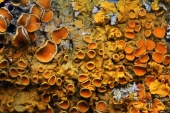Managing trees in Scotland’s open habitats for lichens, bryophytes and fungi (2010) by John Douglass, Gordon Rothero and Liz Holden. Plantlife, ISBN 978-1-907141-15-7
I give this pamphlet 8 out of 10 acorns.
That's more than I gave Mollison!
Pamphlet 24pp
Free Download:
http://www.plantlife.org.uk/application/files/6114/8233/9851/PLINKS_ScotHabitat_LRes.pdf
What am I doing reviewing a pamphlet for one small corner of the planet for this site?
There are several reasons.
As well as their intrinsic value, and many species are increasingly rare, requiring specialist conditions for their survival, lichens, bryophytes (mosses, liverworts and hornworts) and fungi all support aspects of the more complex biotic communities found in healthy ecosystems. Some, especially the fungi, are edible. Many support invertebrate communtities and, through them, predatory vertebrates. Many are involved in soil building, and a few, especially among the lichens, fix nitrogen, supporting the bryophyte communities.
The
open habitats described here, with about 20-50% canopy cover, are often very similar to what we call
forest gardens (most of which are, strictly, savannah habitats), and orchards are specifically discussed. For those intending to create an ark in the face of environmental change, this pamphlet provides useful advice that can often be generalised to many other habitats in temperate and subtropical zones in particular. The open habitats described, from
orchards to wood pastures, are often very similar to those we create. Even where we do not have an existing mature habitat it's worth bearing in mind that it will (we hope) become so one day, with a complex mosaic with fallen or standing dead wood.
The pamphlet concentrates on those lichens, bryophytes and fungi that grow on trees, although the land manager may also want to consider those growing on other substrates, such as walls (or even, as another site user pointed out to me, her old van).
The first thing it does is give a quick list of
basic management recommendations for trees in open habitats, most of which will be relevant to the forest gardener, and many other permies. This is elaborated later but it's generally good advice.
Our habitats will often have limited or zero grazing pressure, with no biocides, limited or controlled fertiliser input, regular pruning and so on. They will also have a diversity of tree species. Many lichen, bryophyte and fungi species have very specific requirements in terms of pH of the substrate (different trees have barks with highly varying pH, from 3.4 for some pines (
Pinus spp) to 7.1 for elms (
Ulmus spp), for example), and forest gardeners are often in an ideal position to provide these conditions, provided we follow careful management protocols, which are typically highly compatible with the rest of our aims.
If we have a site we are just moving on to it's vital to provide ecological continuity, especially if there are ancient or veteran trees present. Varying growth forms will provide a variety of niches to be filled by different species, as will dead wood, both standing and fallen.
The
descriptions of lichen and bryophyte communities are specific to Scotland, but will give the reader some idea what to look for in their own areas. The comparable
description for fungi is a little more general, and potentially more useful (much comes back to the general advice to observe). There are some fungal species known only to fruit on or live in association with trees in open habitats in Scotland, and the same may well be true elsewhere. The permie can give these and others a habitat. Specific edibles, such as Chicken Of The Woods (
Laetiporus sulphureus) are mentioned. Note that heart-rotting fungi may benefit the tree, making it more resistant to storm damage (a tube will flex more than a solid trunk). As Paul Stamets points out, a woodland must be defined partly by its mycota. Symbiosis is common and, while these relationships are less clear with lichens and bryophytes, may also exist in these groups, perhaps with greater than 2-way mutualisms.
The pamphlet has a
list of threats to lichens, bryophytes and fungi, and many of these are, to at least some degree, under the control of the permie gardener. It's well worth acquainting yourself of both these threats and of their positive management needs. There are
specific threats related to grazing in wood pastures, and those engaging in these practices should be aware of them. Identification helps, and the pamphlet gives advice on how to do this, some of which is specific to Scotland, but comparable organisations and experts often exist elsewhere.
There is a long list of
positive management advice, most or all of which would be compatible with permaculture practices although, in particular, one needs to
be careful about firewood collection.
Finally there is a list of
texts, references and web sites. Most of this is specific to Scotland, or at least the UK, but some of it will be relevant elsewhere, and some contacts may be able to put you in touch with experts where you are.
All in all, this is a great little pamphlet, readable in under an hour, accessible for free, with advice that can be generalised elsewhere. Some of the specifics will not be relevant to the general reader, but the management advice and general overview will be useful. Lichens, bryophytes and fungi are key to a healthy permie ecosystem, especially but not exclusively in forest gardens. Even, perhaps especially, if you are considering major land use change to increase diversity in your habitat it's well worth a read.










